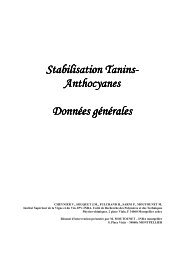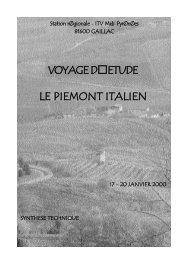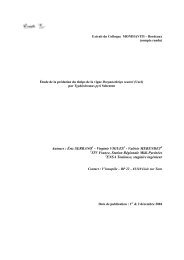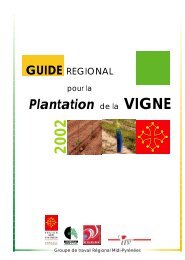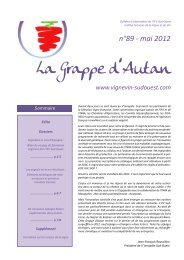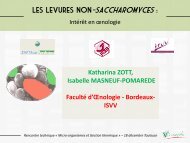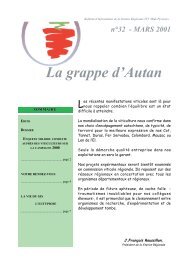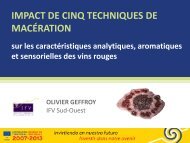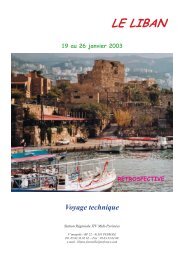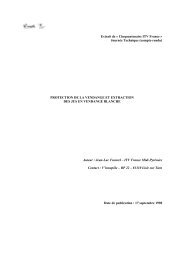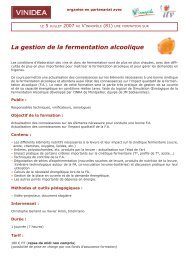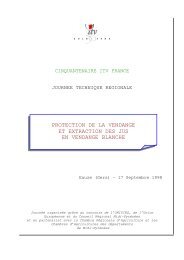Bioconversion de l'acide p-coumarique par Brettanomyces ...
Bioconversion de l'acide p-coumarique par Brettanomyces ...
Bioconversion de l'acide p-coumarique par Brettanomyces ...
Create successful ePaper yourself
Turn your PDF publications into a flip-book with our unique Google optimized e-Paper software.
ethanol before to be ad<strong>de</strong>d in different concentrations in a synthetic winemedium. Two minutes after, a sample was taken and centrifuged. The liquid<strong>par</strong>t was tested on HPLC to <strong>de</strong>tect the p-coumaric acid concentration, and onGC/MS to <strong>de</strong>tect the 4-vinylphenol and 4-ethylphenol content. All the testswere com<strong>par</strong>ed with witness samples free of yeast.2.2. Adsorption tests on PVPP and yeast cell wallsPolyvinylpolypyrrolidone (PVPP) and yeast cell walls were used as twooenological adsorbent in the concentration of 3 g/L.The medium used was a synthetic wine medium free of p-coumaric acid. A 2 3factorial experimental <strong>de</strong>sign was tested to study the variation of the adsorbedquantity Qe (mol/g) of p-coumaric acid ad<strong>de</strong>d in different concentrations.Q e = X/m, where m is the adsorbent mass, and X = Ci (initial concentration) - C e(concentration at equilibrium).The factors tested were the pH (3- 3.5 – 4), the temperature (25, 30, 35 o C) andthe ethanol concentration (10- 11.5- 13 % v/v). The agitation was fixed at 250rpm. All the tests were com<strong>par</strong>ed with witness samples free of adsorbent. Thep-coumaric acid concentrations tested were 2.5 and 20 mg/L, for each adsorbentand for each level of the experimental <strong>de</strong>sign. The contact time for adsorptionwas 5h.3. RESULTS AND DISCUSSION3.1 Adsorption tests in fermentationsResults showed a difference in the adsorption potential of each species. In fact,the brettanomyces sp. showed a better adsorption than the saccharomyces intheir specific conditions (Table 1). There was no 4-vinylphenol or 4-ethylphenol production, corresponding to the lost p-coumaric acid in the contactperiod (2min).Table 1 - Adsorption of p-coumaric acid on <strong>Brettanomyces</strong> sp. andSaccharomyces sp. in fermentation conditionsInitial concentrationp-coumaric (mg/L)Concentration foundp-coumaric (mg/L)Population(10 6 Cell/ml)Saccharomyces 10 9,83 6010 9,53 12010 9,09 240<strong>Brettanomyces</strong> 10 9,1 310 8,4 36010 5,2 450These results confirmed the bibliography datas [7]. In fact, the p-coumaric acidis the less adsorbed phenolic acid by the saccharomyces sp. Its adsorption onbrettanomyces cell walls was recently <strong>de</strong>fined [8].3.2 Adsorption tests on PVPP and yeast cell walls



